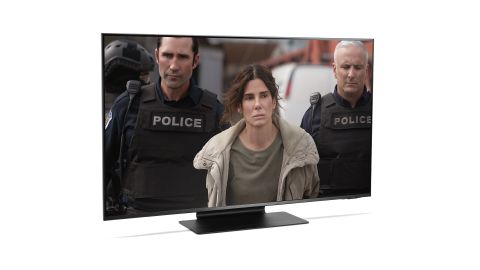Just because a TV is small by today’s increasingly expansive standards doesn’t mean it has to be boring. The 50-inch Samsung QE50QN90A is a case in point: here we have a relatively diminutive screen that throws everything but the proverbial kitchen sink at delivering a premium picture and sound performance to rival the best that its much bigger brethren have to offer.
Price
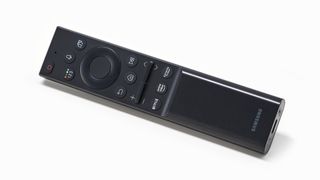
Not surprisingly given the level of specification it boasts, the QE50QN90A sits in the upper fringe of today’s 50-inch TV price bracket. In fact, in most regions it currently costs more than LG’s 48-inch OLED48C1 OLED TV. That’s pretty uncompromising company to be keeping.
Its relatively high price also raises the question of who might pay so much for a relatively small TV when you can get lots more screen inches for your buck elsewhere. However, we’d always – well, nearly always – advocate quality over quantity, and the QE50QN90A has the former in spades. In fact, by the time you’ve taken its use of Samsung’s new Neo QLED technology into account, you could even argue that the QE50QN90A is actually something of a bargain.
Design
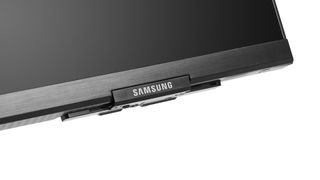
The QE50QN90A looks and feels every inch a premium TV. Its chassis is super thin both around the screen and out the back – enough to make you wonder for a moment if Samsung has quietly turned to OLED technology rather than sticking to its LCD beat. The QE50QN90A really is still a ‘regular’ LCD TV, though – albeit one that finds space in its slender form for a premium direct LED lighting system, where the LEDs sit right behind the screen, and a built-in ‘Object Tracking Sound’ (OTS) audio system.
Build quality is sturdy despite the slim rear, and is set off nicely by a supremely heavy duty, centrally placed desktop stand.
The deep grey finish is crisp and clean, and Samsung’s Ambient Mode lets you run a digitised painting or a photograph on the screen in a special low power mode if you don’t want to be left with a 50-inch black hole when you’re not watching the TV in earnest.
One final cool design feature is that, unusually, the QE50QN90A ships with two remote controls. One fairly regular affair with a fulsome button count but rather plasticky finish, and one smaller, slimmer device with far fewer buttons and, impressively, a solar panel on its rear to save you the trouble of forever having to keep replacing its batteries.
Features
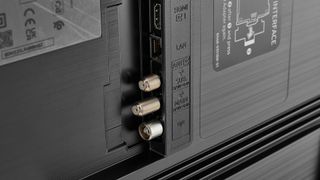
The big story with the QE50QN90A is its use of Samsung’s Neo QLED technology. This essentially describes the combination of Samsung’s Quantum Dot colour and Mini LED technologies. The former delivers a wider potential colour gamut than regular LCD colour filters, while the latter replaces the usual meaty LED backlights with much smaller LEDs shorn of the packing and lenses they’re encased in on normal LED TVs.
Using much smaller LEDs means you can fit many more of them into the same screen area. And if you can fit many more LEDs into the same area, you can also deliver much more granular, localised control over how their light is used to deliver the TV’s pictures. Especially when, as in the 50QN90A’s case, the Mini LED array is driven by an advanced local dimming zone solution powered by Samsung’s latest Neo Quantum 4K processor.
When we say ‘advanced local dimming zone solution’, we mean it. Remarkably, the QE50QN90A can simultaneously deliver different levels of light from no less than 448 separate LED zones. To give this more context, Sony’s 50-inch XBR-50X90J LCD TV uses just 24 local dimming zones.
The result of all this fine light control should be, hopefully, more contrast, more peak brightness, and a wider colour range – all things we look for from any TV that wants to be serious about unlocking the joys of today’s high dynamic range pictures.
The 50QN90A uses a VA panel type, with Samsung’s Wide Angle technology provided to help it retain colour and contrast better when viewed off axis. Please note, though, that it appears that other screen sizes in the QN90A range use IPS-type LCD panels, and so may well exhibit inferior contrast. Don’t assume that the 50QN90A’s picture performance is necessarily representative of other sets in the range.
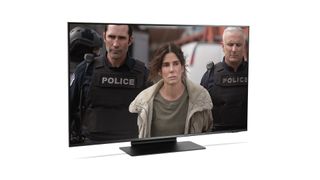
Dimensions (hwd) 644.9 x 1114 x 26.9mm
Processing Neo Quantum 4K processor
Screen size 50-inch
Native resolution 3840x2160
Input lag in game mode 9.2ms
Panel type VA with direct mini LED lighting
The 50QN90A’s connections are all built into the TV rather than integrated into an external One Connect box of the sort provided with Samsung’s flagship TVs. They’re still plentiful, though, including four HDMIs, three USBs and the usual wi-fi and Bluetooth options. One of the HDMIs supports eARC, for passing lossless Dolby Atmos audio out to a suitably capable soundbar or AVR, while HDMI 4 supports the latest gaming features of 4K at 120Hz, VRR (Variable Refresh Rate), and ALLM (Auto Low Latency Mode).
The VRR support even stretches to AMD’s FreeSync Premium Pro system, with its additional colour, brightness and backlight control requirements. It’s just a pity that Samsung has only provided a single HDMI with 4K/120Hz and VRR support when LG’s OLED48C1 TV provides four.
As ever with Samsung TVs, the 50QN90A supports neither Dolby Vision HDR nor Dolby Atmos sound. However, you do get HDR10+, Samsung’s home-grown rival for Dolby Vision which, like that rival, adds extra scene by scene image data to the video stream to help compatible TVs achieve punchier images. It remains a shame Dolby Vision is not supported, though, given how much Dolby Vision content there is these days. Especially now the latest Xbox consoles have embraced the format.
Samsung provides compensation for the lack of Dolby Atmos decoding with an Object Tracking Sound (OTS) system that uses speakers placed around the TV’s frame, rather than just along the bottom, to deliver a larger soundstage and much more accurate placement of specific sound effects than regular built-in TV sound systems can.
Smart features on the 50QN90A come courtesy of Samsung’s Tizen-based Eden platform. This is mostly good news given how compact, customisable and intelligent the interface is, and the way it can be controlled by Bixby, Google Assistant or Amazon Alexa voice recognition systems. It carries all the main streaming apps, too, as well as plenty of more niche options. The only major absentee is Freeview Play. Samsung does provide all the main UK terrestrial broadcaster catch up apps individually at least, but you can’t access them all through Freeview Play’s handy umbrella portal.
Picture
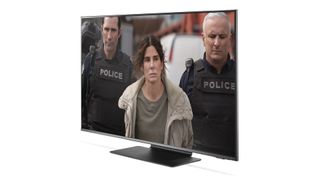
As with the other Samsung Neo QLED TVs we’ve tested recently, the 50QN90A’s mini LED lighting is a revelation when it comes to the sort of contrast we can expect from an LCD TV.
On the one hand black level response is almost unfeasibly good, resulting in dark scenes and dark picture areas so rich and natural that it’s hard to believe you’re not looking at an OLED screen. On the other hand, these excellent and convincing black tones can be punctuated by bright highlights with scarcely a trace of backlight blooming or clouding.
This clear definition between the darkest and brightest parts of the picture is again the sort of thing you’d only normally see on an OLED TV, and transforms how easy it is to become immersed in what you’re watching.
Blooming becomes a little more noticeable if you’re having to watch the 50QN90A from a fairly wide angle, but not nearly as much as you’d expect with LCD screen technology.
Joining the 50QN90A’s terrific contrast is some exceptionally high brightness for a small screen when showing full-screen bright HDR images. Only Sony is capable of getting even brighter than the 50QN90A in the mid-range/small screen market when it comes to the most intense HDR content – but those Sony sets don’t have Mini LED lighting on hand to keep dark scenes free of blooming.
The 50QN90A’s combination of brightness and contrast does a great job of unlocking the extreme range of the QLED colour system, achieving volumes of saturation that leave almost all rivals feeling muted and flat by comparison.
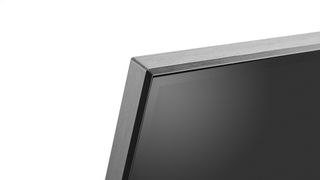
These talents make the 50QN90A a seriously compelling gaming display too, despite the set having to rein in some of its contrast and colour enhancement technologies to deliver its exceptionally low 9.2ms (at 60Hz) input lag time when running in its Game picture mode.
Images look exceptionally detailed and crisp with both video and gaming sources, fully selling the screen’s native 4K resolution despite the relatively small 50-inch screen size. Unlike previous Samsung TV generations, this sharpness doesn’t look forced or over the top, even if you stick with the out of the box sharpness settings and turn off all of the TV’s noise reduction options (which we recommend you do, at least when watching native 4K content).
Samsung’s penchant for sharpness continues to its upscaling of sub-4K content. Samsung has applied AI technology to its upscaling for a couple of generations now with consistently striking results, but the 50QN90A confirms that the technology continues to improve. Especially when it comes to dealing with any compression or colour noise an HD source might contain.
The only catch with the 50QN90A’s upscaling is that it can start to look too fizzy with very grainy sources. This slight harshness can be softened away by the noise reduction options, but this inevitably leads to softer, occasionally slightly processed-looking results. To reiterate this point, though, the fizzing problem only happens with unusually grainy sources. With relatively pristine HD images the 50QN90A’s upscaling is outstanding.
Out of the box the 50QN90A’s motion handling is disappointing. The motion processing system comes on too strong, causing distractingly obvious unwanted side effects such as flickering and blurring around the edges of fast moving objects. Fortunately there’s a fix for this: choosing the Custom motion setting and reducing the judder and blur components to around their three or four level.
Given how clever Samsung’s latest processor is in other ways, though, it seems odd that it’s not better at optimising motion handling without manual intervention.
There are a couple of other issues with the 50QN90A’s pictures too. First and worst, in the most instantly appealing Standard picture preset, pretty excessive amounts of shadow detail can be lost in the darkest parts of the picture unless you nudge up the dedicated Shadow Detail adjustment. Go too far with that, though, and the brightness ‘lift’ it causes can start to have a negative impact on bright parts of the picture.
Second, Samsung’s mostly admirable desire to deliver pictures devoid of any backlight clouding and blooming can see the 50QN90A taking quite a chunk of intensity out of bright highlights that appear against otherwise dark backgrounds. This is one area where self-emissive OLED technology still clearly retains an advantage – and the only way to reduce the problem on the 50QN90A is to use the Movie or Filmmaker Mode presets at the expense of some colour punch and black level depth.
While there’s scope for Samsung to refine the way its Neo QLED panels combine with some of its picture settings with future generations, though, the bottom line is that after a little tweaking the 50QN90A’s pictures are consistently nothing short of spectacular. Especially if you’re the sort of serious film or gaming fan who likes to dim the lights when indulging your favourite pastime.
Sound
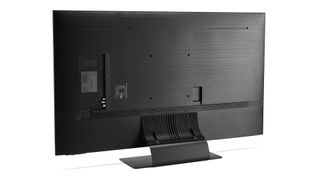
For the most part the 50QN90A’s speakers give a strong account of themselves. Instantly noticeable versus typical TV sound systems is how far the sound spreads beyond the boundaries of the TV’s frame, and how rounded the sound is, with a decent amount of bass depth to underpin and counterbalance the reasonably open midrange and clean treble.
Also striking as you listen for longer is how accurately specific effects such as voices, gun shots, engine rumbles and so on are placed both on and off the screen. The 50QN90A may not have a Dolby Atmos decoder, but it often sounds more ‘spatial’ than many TVs that do. It’s worth adding, though, that if this feature appeals to you its effect is more pronounced on larger screen sizes.
If you happen to add a recent Samsung soundbar to the 50QN90A, the two can join forces to deliver a larger, higher soundstage with even more accurately positioned vocals. The TV’s speakers are well-rounded enough to harmonise with those of the soundbar surprisingly well.
Given how powerful the 50QN90A typically sounds, it’s a shame that its output can suddenly start to fall back rather than continuing to climb to a crescendo when a soundtrack starts to get really dense and loud. It’s true to say, too, that much of the 50QN90A’s soundstage doesn’t project forward into your room; everything seems to exist in front of you, on a level with or even at times behind the screen.
Verdict
While you need to tweak a couple of things to get the best out of it, a well set up 50QN90A proves that Samsung’s Mini LED-driven Neo QLED technology is capable of elevating the brand’s TVs to new OLED-challenging performance heights even at a relatively mainstream size.
SCORES
- Picture 5
- Sound 4
- Features 5
MORE:
Read our review of the LG OLED48C1
Also consider the Philips 48OLED806
These are the best 48, 49 and 50-inch TVs you can buy
